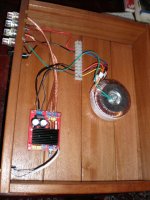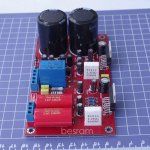Uhm, an amplifier for 48 thousand dollars is note exactly cheap. I wonder if the's something wrong with the pricing...
I bough the same thing for 27$ in total, well the intake caps were way too small so i added 10kuf caps, im useing 12v so due the low power, i cant save as much as it needs
also bought 8" dual 8 ohm 120w coil subwoofer.
when i got them i hooked everything up, also 4 4 ohm mids and 2 tweeters wich were all of them 4 ohm, i hooked up as parallel to not to overflow my amp
well dual 2 ohm 110w resistors were added in progress to maintain 8 ohm load.
also its really good amplifier.
lol im 17 and u can call me stupid kid, when im wrong u can always fix my fails so i could learn something for "masters".
also bought 8" dual 8 ohm 120w coil subwoofer.
when i got them i hooked everything up, also 4 4 ohm mids and 2 tweeters wich were all of them 4 ohm, i hooked up as parallel to not to overflow my amp
well dual 2 ohm 110w resistors were added in progress to maintain 8 ohm load.
also its really good amplifier.
lol im 17 and u can call me stupid kid, when im wrong u can always fix my fails so i could learn something for "masters".
Iron core
also interestingly it uses 5W power even when silent, and hence (with the smaller heatsink) runs a lot hotter.
The reason for this dissipation is ferrite core of the output inductance. It probably runs into saturation and allows dissipative leakage... Toroidal iron core is better in this range of switching frequencies. Above few megahertz ferrite is better.
This dissipation does no have influence on sound, just dissipation (and may lead to frying the chip, not only making it run hotter).
Bigger PSU caps, with lower ESR (important!) can bring distorsion down.
Well i had an cheap board but the cheapest one for like 18$
It sounded pretty damn sweet even with terrible output inductors and even worse supply filter.
The chip were genuine, now what i have done is i made new board for output, bigger inductors, gigantic ferrite cores, new input filters removed resistors and made new input stage with alps pot rk27
New panasonic ultra low ESR filters 35v 6800 each, dint fit well yet it works out
Abit bigger copper heatink from old graphics card and so on...
It sound neat indeed and output is super clear sounds very strong but yet the output power isnt as high as LM3886 gainclone but sounds similar, but 8950 is totally different
It sounds so warm it could light ur ears up
It sounded pretty damn sweet even with terrible output inductors and even worse supply filter.
The chip were genuine, now what i have done is i made new board for output, bigger inductors, gigantic ferrite cores, new input filters removed resistors and made new input stage with alps pot rk27
New panasonic ultra low ESR filters 35v 6800 each, dint fit well yet it works out
Abit bigger copper heatink from old graphics card and so on...
It sound neat indeed and output is super clear sounds very strong but yet the output power isnt as high as LM3886 gainclone but sounds similar, but 8950 is totally different
It sounds so warm it could light ur ears up
TDA8920B DC Offset
I notice the TDA8920B datasheet quotes dc offset at 150mV (maximum). No 'typical' figure is quoted. Can anyone tell me if 150mV is typical?
Is if there is any way to null the offset?
Tim
I notice the TDA8920B datasheet quotes dc offset at 150mV (maximum). No 'typical' figure is quoted. Can anyone tell me if 150mV is typical?
Is if there is any way to null the offset?
Tim
I Realize this might be a stupid question...
20-0-20 is what this board calls for do you think it would work or could be modified to take 24-0-24 at 3A
20-0-20 is what this board calls for do you think it would work or could be modified to take 24-0-24 at 3A
Have you tried solo piano? It would be nice to know if these module do not have the "piano" fuzz. I have several 8950th based modules, and they all have this fuzz on piano notes. It's not noticable on pop and rock recordings. But solo instruments, like piano and classical guitar or the like all have this fuzz (like a faint distortion on top of the note)
Excuse my total amateur question, but I want to use this for a guitar power amp and was wondering how to run it in BTL mode. Is it just bridging the solder jumpers on the bottom (which I presume just ties the inputs together) and connecting +R to +L and -R to -L?
I will gladly have a listen for "piano fuzz" when I am listening to Sati.
These modules seem too good for the price.
Why aren't they more common?
These modules seem too good for the price.
Why aren't they more common?
I could not hear any "fuzz".
I did notice that the bottom end is better than the top end.
Do these little amps take a while to warm up?
They seem to be quite cool (heat wise) until you actually start running the volume. After which about 10 minutes, the thing sweetens up 🙂
I also have a tda7293. Would this sound better in your opinion?
I did notice that the bottom end is better than the top end.
Do these little amps take a while to warm up?
They seem to be quite cool (heat wise) until you actually start running the volume. After which about 10 minutes, the thing sweetens up 🙂
I also have a tda7293. Would this sound better in your opinion?
I could not hear any "fuzz".
I did notice that the bottom end is better than the top end.
Do these little amps take a while to warm up?
?
The TDA8950 is the same - very very good bottom end and adequate top end. The distortion is highest at 6 khz and it's a pre filter design, which means that the amplifier is more sensitive to speaker load, but could in theory also sound better than post filter.
Last edited:
Just had a listen to some harp concertos from the 1800's. Could not hear any fuzz at all. If anything, I could hear the finger nails scratching on the strings 🙂
I also have a tda7293. Would this sound better in your opinion?
Probably not on the bass, classD normally wins there. If you have a 2 way active system, put the TDA7293 on the tweeter in bridged and use a ferrite output transformer to step down the voltage. Driving into a higher impedance load makes them so much sweeter at the top.
I am currently using a 3 way passive crossover.
Thanks for your advice, I might get to bi-amping at a later date.
I am currently working on a 2 way pair of speakers and with passive crossovers.
Another member mentioned that adding some larger caps will improve bass.
Have you found this to be the case?
Thanks for your advice, I might get to bi-amping at a later date.
I am currently working on a 2 way pair of speakers and with passive crossovers.
Another member mentioned that adding some larger caps will improve bass.
Have you found this to be the case?
- Status
- Not open for further replies.
- Home
- Amplifiers
- Class D
- inexpensive YuanJing TDA8920 board from ebay

